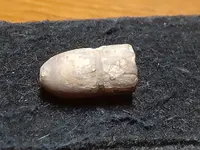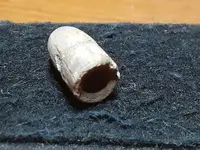Umbrahabitator
Jr. Member
Hello,
I found an interesting bullet today and seek the wisdom of the forum members to aid in its' identification. I had previously found a bullet and posted it to the What Is It thread; it was identified as a .36-S&W. This bullet appears to be very similar but I do not know enough about bullets to determine it's age and relevant details.
This is what I know about bullet:
.36" diameter
.67" length
One ring
Hollow base
One side is partially flat
Thank you for all the help.


I found an interesting bullet today and seek the wisdom of the forum members to aid in its' identification. I had previously found a bullet and posted it to the What Is It thread; it was identified as a .36-S&W. This bullet appears to be very similar but I do not know enough about bullets to determine it's age and relevant details.
This is what I know about bullet:
.36" diameter
.67" length
One ring
Hollow base
One side is partially flat
Thank you for all the help.





